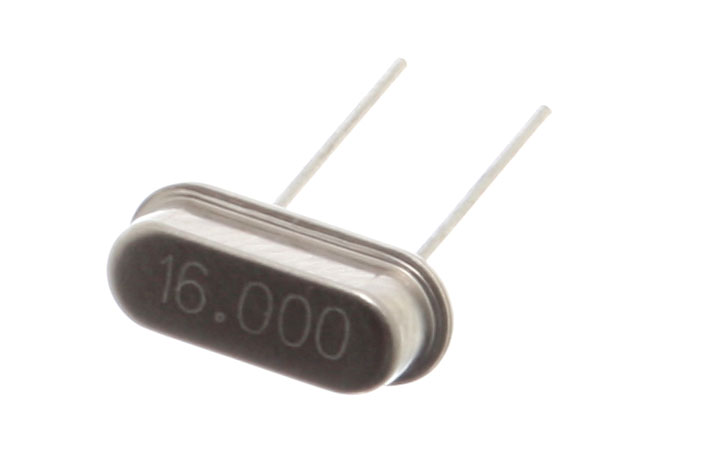Crystal
A crystal in the context of electronics refers to a solid material whose atoms, ions, or molecules are arranged in a highly ordered and repeating pattern that extends in all three spatial dimensions. This orderly structure, called a crystalline lattice, is what gives crystals their unique properties, including their ability to interact with electrical signals in specific ways. Crystals are widely used in electronic devices for a variety of purposes, particularly in oscillators and frequency control applications, such as in clocks, radios, and computers.
One of the most common types of crystals used in electronics is the quartz crystal. Quartz is a natural mineral made of silicon dioxide (SiO₂), and its piezoelectric properties make it highly useful in electronic circuits. Piezoelectricity refers to the ability of a crystal to generate an electric charge when subjected to mechanical stress, and vice versa, where an electric field can cause the crystal to change shape. This property is key in crystal oscillators, where a quartz crystal vibrates at a very precise frequency when an electric voltage is applied across it. These oscillations are highly stable and can be used to generate consistent time signals or frequencies, making quartz crystals essential for applications like watches, GPS systems, and radio transmitters.
Crystals are also integral to frequency stabilization. For example, in radio receivers, a quartz crystal can be used as a frequency filter, allowing only signals of a particular frequency to pass through while blocking others. This precision is crucial for tuning radios to specific stations. In microprocessors, crystals are used to maintain accurate clock signals, which synchronize the operations of the chip, ensuring that data processing occurs at the correct intervals. In these cases, the crystal's natural resonant frequency is used to regulate the timing and operation of the entire system.
The performance of a crystal is influenced by factors such as temperature, which can affect its frequency. Crystals are often enclosed in protective casings to minimize the impact of environmental conditions and ensure long-term stability. There are also different types of crystals with varying properties, such as fundamental mode crystals and overtone crystals, which vibrate at integer multiples of their fundamental frequency.
Beyond their use in oscillators, crystals are also found in sensors and transducers due to their piezoelectric characteristics. For instance, they are used in medical imaging equipment like ultrasound machines and in microphones and speakers. In each of these applications, the crystal's ability to convert mechanical vibrations into electrical signals (or vice versa) is leveraged to detect, measure, or transmit data.
In conclusion, crystals are integral to modern electronics, providing precision frequency control and energy conversion capabilities across a wide range of applications. Whether it's stabilizing a clock signal, tuning a radio, or sensing vibrations, the unique properties of crystals are indispensable to the operation of many electronic devices.
One of the most common types of crystals used in electronics is the quartz crystal. Quartz is a natural mineral made of silicon dioxide (SiO₂), and its piezoelectric properties make it highly useful in electronic circuits. Piezoelectricity refers to the ability of a crystal to generate an electric charge when subjected to mechanical stress, and vice versa, where an electric field can cause the crystal to change shape. This property is key in crystal oscillators, where a quartz crystal vibrates at a very precise frequency when an electric voltage is applied across it. These oscillations are highly stable and can be used to generate consistent time signals or frequencies, making quartz crystals essential for applications like watches, GPS systems, and radio transmitters.
Crystals are also integral to frequency stabilization. For example, in radio receivers, a quartz crystal can be used as a frequency filter, allowing only signals of a particular frequency to pass through while blocking others. This precision is crucial for tuning radios to specific stations. In microprocessors, crystals are used to maintain accurate clock signals, which synchronize the operations of the chip, ensuring that data processing occurs at the correct intervals. In these cases, the crystal's natural resonant frequency is used to regulate the timing and operation of the entire system.
The performance of a crystal is influenced by factors such as temperature, which can affect its frequency. Crystals are often enclosed in protective casings to minimize the impact of environmental conditions and ensure long-term stability. There are also different types of crystals with varying properties, such as fundamental mode crystals and overtone crystals, which vibrate at integer multiples of their fundamental frequency.
Beyond their use in oscillators, crystals are also found in sensors and transducers due to their piezoelectric characteristics. For instance, they are used in medical imaging equipment like ultrasound machines and in microphones and speakers. In each of these applications, the crystal's ability to convert mechanical vibrations into electrical signals (or vice versa) is leveraged to detect, measure, or transmit data.
In conclusion, crystals are integral to modern electronics, providing precision frequency control and energy conversion capabilities across a wide range of applications. Whether it's stabilizing a clock signal, tuning a radio, or sensing vibrations, the unique properties of crystals are indispensable to the operation of many electronic devices.
